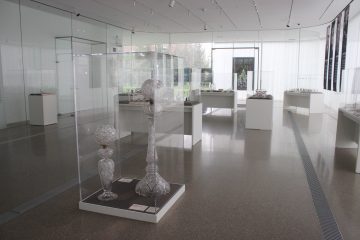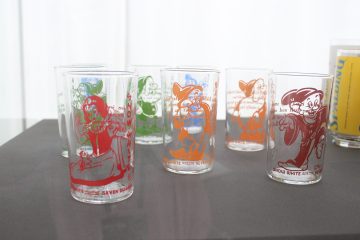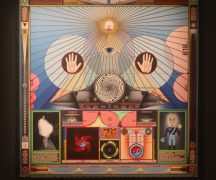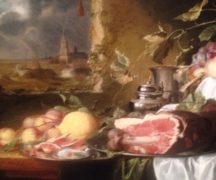By DAVID DUPONT
BG Independent News
Given how associated Libbey Glass is with Toledo, it is easy to forget the company’s roots are 800 miles east in Cambridge, Massachusetts.
What started as the New England Glass outside of Boston really started to glow when Edward Drummond Libbey packed up the operation equipment, processes, and workers, and made the trek west to Toledo in 1888.
Libbey, who had taken over the company from his father, was leaving behind labor troubles to come to a place that offered an ample supply of gas to run their glass works, and deposits of silica-rich sand to melt into glass.
 New England Glass became Libbey Glass, and Toledo became the Glass City. That name is not the only legacy the family left to the city. Libbey and his wife Florence Scott Libbey, also founded the Toledo Museum of Art, and their endowment continues to support it. So a visitor can see “Celebrating Libbey Glass: 1818-2018” for free in the museum’s Glass Pavilion through Nov. 25.
New England Glass became Libbey Glass, and Toledo became the Glass City. That name is not the only legacy the family left to the city. Libbey and his wife Florence Scott Libbey, also founded the Toledo Museum of Art, and their endowment continues to support it. So a visitor can see “Celebrating Libbey Glass: 1818-2018” for free in the museum’s Glass Pavilion through Nov. 25.
Diane Wright, who was appointed the curator of glass last fall, organized the show. This exhibit, she said, gave her the opportunity to “dive into local history, and the legacy of glass in Toledo.
The museum reputation as one of three encyclopedic collections of glass was well known to Wright, whose resume includes cross-continental stops at key spots in the tradition of American glass from the Corning Glass Museum in New York State’s Southern Tier to the Pilchuck Glass School in Seattle.
Toledo’s collection includes more than 600 pieces of Libbey Glass, of which 150 are on display. Another 45 in the show are on loan from Libbey and private collectors. Those nearly 200 items cover the story from before any Libbeys were involved. It represents the first 70 years back in Massachusetts with items of glass serving ware, high end functional ware.
At the time of its move, the glass company was part of the Brilliant Glass Movement. Glass blocks were cut as if they were diamonds to achieve a similar luster.
The most famous of these was the striking Libbey punch bowl, now a prized part of the museum’s collection. It and other show pieces were created to display at the 1893 Columbian Exhibition in Chicago and the St. Louis World’s Fair in 1904. Libbey staged lavish displays of glass. These were intended to buff the company’s reputation as the producer of elegant, sophisticated works.
 These still dramatic pieces are the stars of “Celebrating Libbey.”
These still dramatic pieces are the stars of “Celebrating Libbey.”
But the exhibit is also a testament to the company’s ability to change with the times. World War I disrupted global markets, and Libbey focused more on consumer goods. After World War II it provided stylish, yet functional, glassware for the growing middle class.
It was also creating memories for the children in those homes. In 1939 Disney approached Libbey about producing glasses decorated with the figures from its first animated feature, “Snow White and the Seven Dwarfs.” This kind of movie tie-in marketing was in its infancy, and Libbey obliged in its growth with The Jetsons and Star Wars glasses among the various characters joining Snow White.
A display of cocktail glasses reflects the company following a contemporary trend as does the set of beer flight glasses.
Libbey continued to evolve. Its success was based on keeping up with the times, and continuing to innovate through affiliated companies whether it was in the production of bottles and jars or in the production of automotive and architectural glass. That’s outside the purview of the show.
“Celebrating Libbey Glass,” held in the museum its money built, shows that the Libbey name has kept its luster.





